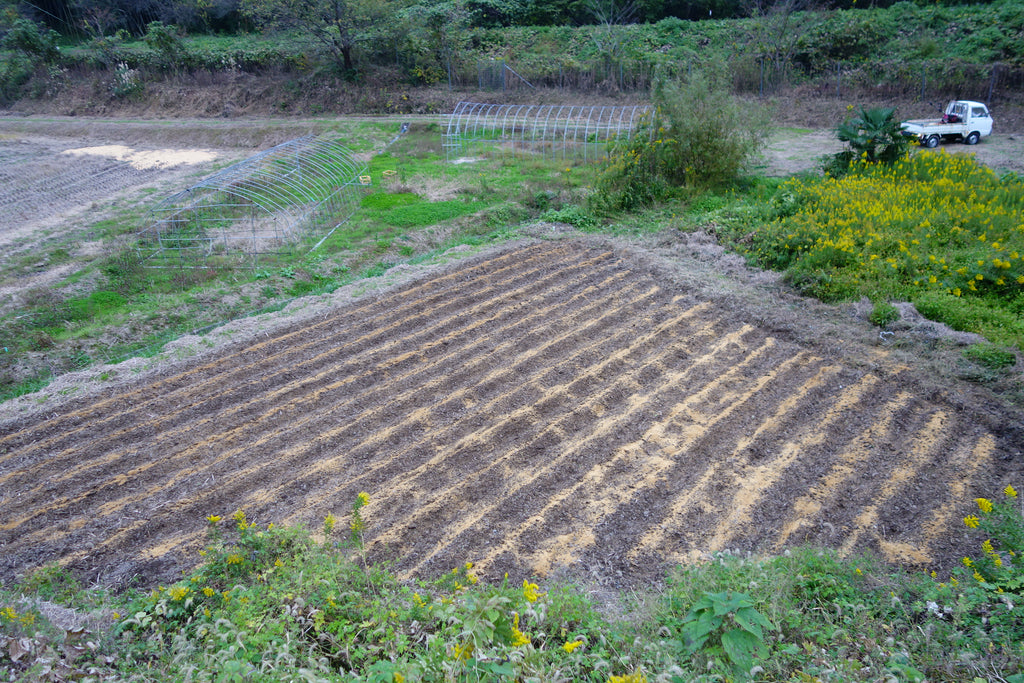Last fall, I rented a small field in the mountains of Otaki Town.

The land was originally a rice field, but it fell into disuse and was rented out after land rezoning. The land was triangular, measuring just 15m on each side, and was on the edge of the land with no tenants. It was difficult to operate agricultural machinery on the land, so it hadn't been used for over a dozen years.
That's why we thought it was perfect for us, who were visiting for the first time.
We will be cultivating rye together with the land owner, Mr. Noguchi, and mitosaya's natural living teacher, Mr. Kimijima from AMBESSA.
We named this land the Mitosaya Triangle Field. First, we dig up the soil and turn it into a field.

The land, which had not been used for many years, was full of weeds, very hard, and made of clay.
We tried to till the land with a hand tiller, but the kudzu roots quickly popped up and the clods of mud clung to the tiller, making it difficult to make any progress.
Despite the difficulties, I plowed the field twice. (By the way, people around here say "unaru" when they plow the field. Is this a dialect or a technical term?)

Next is making the ridges. Here too, a hand-operated ridge-making machine is used to make the ridges while plowing. The ridges are about 20cm high, with the flat part of the mound about 30cm.
To improve drainage, use a hoe to make the furrows deeper and then the garden is complete.
It's starting to look like a field, but there's still a long way to go.
Next, we drag a pole across the middle of the mountain to dig a trench to sow the wheat, and then we can finally start sowing it.
Hold the seeds in one hand and spread them evenly between the pads of your thumb and index finger. It is said that they will not grow well if they are spread too thinly or too thickly, but this is difficult.
It took three adults almost a whole day to finally sow the wheat.
After about two weeks, sprouts will appear in the area where the wheat was sown.

In winter, we also trample the rapidly growing wheat to prevent it from lifting the soil.
I'll watch it grow while pulling out the weeds a few times.

By the time of Golden Week, it will have grown to about the same height as a child.

The ears appear at the same time, but at first, they only contain a white liquid.
Grains gradually appear inside the ears. As the wheat grows taller and the ears grow larger, the stalks and ears turn brown, the ears become heavy, and when they start to droop, it's time to harvest the wheat.

At the end of June, the three of us got together again to harvest the wheat. Here too, the hand-pushed harvester was put to great use. We collected the fallen wheat by hand, tied it with rope, and dried it in a drying area we made under the eaves. This is called "odakake" in this area.

Normally, they would want to dry the rice for about two weeks, but since we are in the middle of the rainy season and the humidity is high, the rice would sprout if exposed to rain, so Kimijima decided to stop drying after two days and thresh the rice with a harvester .

I separated the rye into rice and straw, and decided to dry the rice in the sun after the rainy season. The harvest yield was about 25 kg. It was a good rye with large grains for my first attempt.
I dried it in the sun and took it inside in the evening, repeating this process several times before storing it.
Getting ready for the next wheat sowing.

Meanwhile, the wheat straw is finally being turned into straws. With the help of the Nakazato Work Home, a vocational facility for the intellectually disabled in Minamiboso, we cut the best parts of the straw, about the size of a garage, to the specified length.
A few months later, the neatly cut straw arrived.

After boiling and disinfecting the straw, it is thoroughly dried in a dryer. After that, it is inspected and the rye straw is complete.
About a year has passed since sowing a single grain of rye in the soil. Because it is a natural material, there is some variation in thickness, but about 20,000 straws with a beautiful luster and just the right amount of firmness have been produced.
Since it is a straw made from wheat, I named it Straw Straw. I thought I had worked hard to create something new, but in reality, I was just making the original straw . I was reminded that ignorance is a wonderful driving force in the creation of things.
The number of bottles, the packaging, and the price. There was a lot of debate about that, but I'll skip it because it would be too long.

Another new year begins.
This year we were able to rent a new, larger plot of land.
It is a rectangular piece of land of about 1 tan (300 tsubo). I also planted wheat on this land the other day.
Of course, there is also the mitosaya triangular field.
Please be patient until this rye becomes whiskey someday.

Last fall, we rented a small field in the mountains of Otaki Town.

The land was originally a rice field, but it was no longer in use, and we rented it out after the land was rezoned. It was a triangular piece of land with only about 15 meters on each side. It had not been used for anything for more than ten years because it was difficult to maneuver farm machinery.
That's why we thought it would be perfect for our first time.
Together with Mr. Noguchi, the owner of the land, and Mr. Kimishima of AMBESSA, mitosaya's natural life teacher, we will be growing rye.
We named this land "mitosaya triangle field. First, we dig up the soil and turn it into a field.

The land, which has not been used for many years, is covered with weeds and is very hard and clayey.
We started plowing with a hand-pushed tiller, but the kuzu roots that soon appeared and the clumps of muddy soil that clung to the tiller made it difficult to proceed.
We plowed twice with difficulty.

The next step is to make ridges. The height of the ridges is about 20cm and the flat part of the mountain is about 30cm.
To improve drainage, we used a hoe to make the furrows even deeper.
It's starting to look like a field, but there's more to come.
Next, we dragged a stick to the middle of the mountain and dug a trench for sowing wheat.
Holding the sticks in one hand, sow the wheat evenly between your thumb and forefinger. It is said that neither dense nor sparse sowing will result in poor growth, but this is difficult.
It took three adults almost a day to finally sow the wheat.
After a couple of weeks, the wheat sprouted slightly where we had sown it.

Stepping on the growing wheat is another thing we do in winter to keep it from lifting the soil.
We watch them grow while we weed them several times.
By the time mid May comes around, they will have grown as tall as a child.

At the same time, ears start to appear, but in the beginning, there is only a white liquid inside the ear.

Gradually, the ears begin to bear fruit. As they grow taller and the ears get bigger, the stalks and ears turn brown, and the ears get heavier, and when they start to hang their heads, it's time to harvest the wheat.

At the end of June, the three of us gathered again to harvest the wheat. Again, the hand-pushed reaper was very active. We gather up the fallen barley by hand, tie it up with string, and dry it in a drying area under the eaves. This is called "oda-gake" in this area.

Normally, we would like to let them dry for about two weeks, but it is very humid in the middle of the rainy season, and if they are exposed to rain, sprouts will appear, so Mr. Kimishima decided to end the drying after two days. We will thresh them with a harvester.

The fir will be dried in the sun after the rainy season. The harvest was about 25 kilograms. It's a good crop for the first time, with large grains of rye.
After drying them in the sun and taking them in in the evening, we stored them.
It is now ready for the next sowing of wheat.

On the other hand, the straw is finally made into “straw”. With the help of the people at the Nakazato Work Home, a vocational facility for the mentally handicapped in Minamiboso, we cut the best parts of the straw to the specified length.
A few months later, we received the neatly cut straw.

After boiling and disinfecting it, we dry it thoroughly in a dryer. After that, the straw is inspected and the rye straw is ready.
It takes about a year from the time a single grain of rye is sown into the soil. Because it is a natural material, the thickness of the straws varies, but we were able to about 20,000 straws with a beautiful luster and moderate elasticity.
We named the straws "Straw Straw" because they are made of wheat. I thought I was trying my best to create something new, but to be honest, I was creating the original straw itself, which reminded me once again that ignorance is a wonderful driving force in manufacturing.
The number of straws, the packaging, and the price. We had a lot of arguments about that, but it's a long story. This is how it turned out.

Another new year is about to begin.
This year, we were able to rent a large plot of land.
It's a rectangular piece of land about one hectare in size. We sowed wheat on this land the other day.
Of course, we also sowed wheat in the mitosaya triangular field.
Please be patient with us until this rye turns into whiskey one day.





